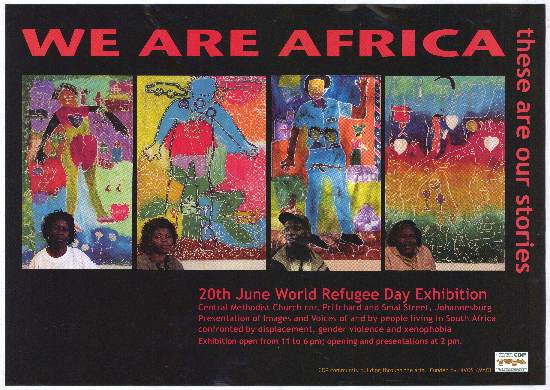World Refugee Day was established in late 2000 by the United Nations General Assembly in Resolution 55/76 as a way of drawing attention to the ever-growing global plight of displaced persons. The date was chosen to coincide with African Refugee Day, a date already commemorated by the Organization of African Unity (OAU), the predecessor of the African Union (AU). In 2010, the theme for World Refugee Day is ‘home,' commemorating the plight of over forty three million displaced persons worldwide.
Ongoing political conflict in Afghanistan resulted in one of the largest refugee crisis in the world, numbering 2.9 million. In South Africa, refugees have come from all over Africa, including over three million displaced Zimbabweans. The refugee problem in South Africa was made worse in May, 2008, when an outbreak of xenophobic violence resulted in the displacement of millions of foreign African nationals. The notoriety of these attacks, as well as poor treatment in deportation centres, including the Lindela Repatriation Centre in Krugersdorp, has evoked a legacy of anti-foreigner sentiment anathema to the protection of the human rights of refugees.
World Refugee Day also commemorates the historical legacy of forced migration. Solidarity with refugees and displaced persons was first commemorated in 1914, when Pope Pius X of the Roman Catholic Church instituted the World Day of Migrants and Refugees. In 1951, the United Nations held a conference in Geneva to draft a Convention recognising the legal rights of refugees in international law. This led to the Convention on the Status of Refugees, adopted on 28 July, 1951.
Learn more about the United Nations Convention on the Status of Refugees.
Refugees are individuals who have been forced to leave their homes for any number of reasons, including political conflict, persecution, natural disasters and climate change. The definition of displaced persons has expanded to include not only those who have left their countries, but also internally displaced persons. According to a United Nations report on the human rights of internally displaced persons, finding a solution for the problem of internally displaced persons involves
"...a complex process of gradually achieving a situation where the internally displaced no longer have any displacement-specific needs and can enjoy their human rights without discrimination related to their displacement."
Learn more about the UN Special Mandate on the human rights of internally displaced persons.
We are Africa: these are our stories
In 2008, in response to the xenophobic attacks, the CDP ran a Displaced Persons workshop for "people living in South Africa confronted by displacement, gender violence and xenophobia," providing them with a creative and therapeutic outlet, reflected in the banners below.

On World Refugee Day in 2010, the implications of being forced to abandon home - leaving behind the security of family, community, resources and shelter - are emphasized in events held throughout the world.
The South African History Archive commemorates World Refugee Day, in sympathy with the millions forced to leave their homes - which includes the security of family, community, resources and shelter.
As a part of this drive to highlight the problem, and counter the negative influence of xenophobia, we are interested in material related to forced migration, refugees and internally displaced persons.
If you have material to donate, or wish to learn more about our collections, please contact the SAHA Archives.





